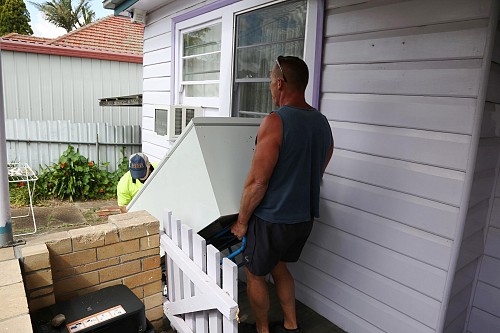Learn How To Move A Refrigerator – The RIGHT Way
 If you’re wondering how to move a refrigerator, you’ve probably been picturing a couple of husky humans hauling the fridge out of your house and onto a truck. However, frequent movers (like yours truly) have learned that muscle power is just a part of the story. Moving a fridge requires careful preparation, protection, and aftercare to avoid damaging any delicate components.
If you’re wondering how to move a refrigerator, you’ve probably been picturing a couple of husky humans hauling the fridge out of your house and onto a truck. However, frequent movers (like yours truly) have learned that muscle power is just a part of the story. Moving a fridge requires careful preparation, protection, and aftercare to avoid damaging any delicate components.
Here’s how to move a refrigerator the right way, based on tips provided by Wayne Archer, Sears PartsDirect DIY expert.
Prep and Protection
1. Before the move, make sure your refrigerator will fit in the available space with about 1-inch clearance around the top and sides. (This enables proper air circulation, allowing the fridge to work at maximum efficiency.)
2. Use up perishables as much as possible. If you must store some food temporarily, have a fridge pouch or cooler chest and ice on hand.
3. Empty all food from the fridge and unplug. Do this 24 hours before moving if you have frost buildup in the freezer compartment, so the frost will have time to melt. Wipe up any liquid from the melted frost.
4. Clean the refrigerator interior to minimize odors, especially if the fridge won't be reconnected for some time.
5. Either remove racks, shelves, crispers and storage bins, or fasten securely in place with no-residue tape.
6. If your refrigerator has an automatic icemaker, turn off the house water valve that supplies water to the fridge and then disconnect the water line. Keep a towel handy to wipe up spills.
7. Protect the power cord; tape or tie it onto the back of the refrigerator.
8. Take off the bottom back panel and sponge or Shop-Vac the water from the defrost drain pan so it doesn’t spill. Reinstall the bottom back panel.
Moving the Refrigerator
9. Load the fridge with a moving dolly and a helper. It’s okay to tilt the refrigerator when loading, but avoid laying it on its side (not good) or back (much worse!) for the actual move. This minimizes possible damage to the sealed system that would cause serious cooling problems later.
10. Secure the refrigerator with cargo straps to keep in position during transit. Hold the doors closed using rope or plastic tape. Cover the front and sides of the fridge with padding to prevent scratches.
11. If you remove the refrigerator door to fit through the kitchen door (at either end of the move), secure all trim, hinges, screws and other hardware in the refrigerator so you don’t lose them.
12. Before bringing the refrigerator into your new home, use a coil brush to clean the condenser coils.
Installing the Refrigerator in its New Home
13. Position the refrigerator in front of its intended location, leaving room for someone to get behind. Hook up the house water line to the refrigerator and turn on the water supply valve. Check all water line connections and repair any leaks. (Find a plumber for serious leakage.) Plug in the appliance.
14. Slide the refrigerator into place. Push the top of each front corner back and forth; if the fridge rocks, adjust the leveling feet. Open the doors halfway and then let go. If they swing shut too quickly or don’t close at all, adjust the feet so the refrigerator cabinet front is ¼” (or half bubble on a level) higher than the back.
15. Purge air from the water lines by running water through the water dispenser for a short time until the flow is smooth.
Before Storing Food or Making Ice
16. If you absolutely had to lay the fridge on its side for transport, let it stand upright the same amount of time before plugging it in. (For example, if the fridge was on its side 2 hours, leave it upright and disconnected for another 2 hours.)
17. After the refrigerator is in place and plugged in, set the controls and let run for 24 hours, to allow it to cool to an optimal temperature, before putting food inside.
18. Give the icemaker 48 hours to start producing ice. Dispose of the first two or three batches in case dirt got into the ice mold or water lines during the move.
Laura Firszt writes for networx.com.
Looking for a Pro? Call us (866) 441-6648

Average Costs
Related Experiences

Parking Lot Lights Restored So Employees Can Reach Cars Safely

We Needed A New Bathroom Vent Fan To Get Our House Renter-Ready



